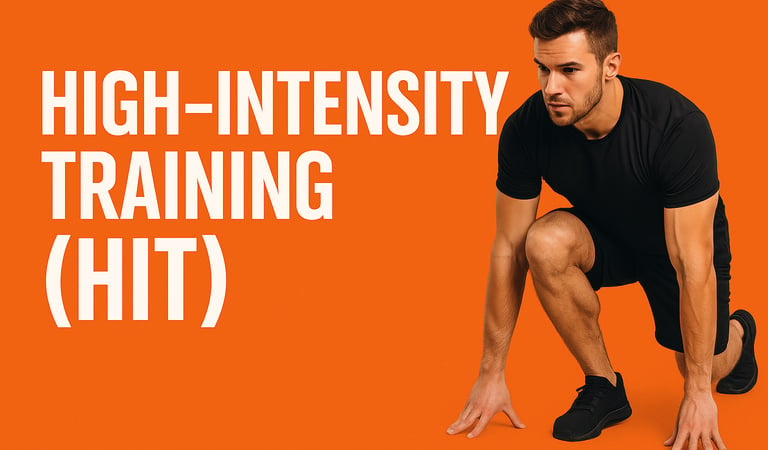High-Intensity Training (HIT): A Comprehensive Guide to Smarter Workouts
High-Intensity Training (HIT) has gained immense popularity in recent years for its time efficiency, efficacy, and adaptability to various fitness levels. Whether you're a busy professional, an athlete, or someone aiming to break through fitness plateaus, HIT offers a science-backed, effective approach to improve strength, endurance, and overall health.
MOBILITY
5/25/20253 min read


High-Intensity Training (HIT): A Comprehensive Guide to Smarter Workouts
High-Intensity Training (HIT) has gained immense popularity in recent years for its time efficiency, efficacy, and adaptability to various fitness levels. Whether you're a busy professional, an athlete, or someone aiming to break through fitness plateaus, HIT offers a science-backed, effective approach to improve strength, endurance, and overall health.
What is High-Intensity Training (HIT)?
HIT is a form of strength or cardio workout that involves short, intense bursts of effort followed by controlled recovery periods. The goal is to maximize effort during the work phase, stimulating muscle growth and cardiovascular improvements in a shorter timeframe compared to traditional steady-state exercises.
Benefits of HIT
1. Efficiency
HIT sessions typically last 15–30 minutes, making it perfect for those with tight schedules.
Studies show comparable or superior results to longer, moderate-intensity workouts.
2. Improved Cardiovascular Health
HIT enhances heart health by improving blood flow and reducing blood pressure.
It increases VO2 max, the measure of your aerobic fitness.
3. Enhanced Metabolic Rate
Post-exercise oxygen consumption (EPOC) ensures your body continues burning calories even after the session.
It improves insulin sensitivity and aids fat loss.
4. Muscle Growth and Strength
HIT encourages hypertrophy (muscle growth) due to the high intensity and short rest periods.
It can target both slow-twitch and fast-twitch muscle fibers.
5. Flexibility in Equipment and Space
HIT can be done at home, in the gym, or outdoors.
It requires minimal equipment, often relying on body weight exercises.
Components of a HIT Session
1. Warm-Up (5–10 minutes)
Dynamic stretches, light jogging, or cycling to prepare the body.
Reduces the risk of injury and enhances performance.
2. Main Workout (10–20 minutes)
Alternates between high-intensity work and rest periods.
Work: 20–45 seconds at maximum effort.
Rest: 10–60 seconds depending on your fitness level.
Example exercises: burpees, sprinting, kettlebell swings, push-ups, or rowing.
3. Cool-Down (5–10 minutes)
Stretching and light cardio to help lower heart rate.
Promotes muscle recovery and flexibility.
HIT Variations for Different Goals
1. Weight Loss
Exercises: Jump squats, mountain climbers, and high knees.
Timing: 30 seconds work, 15 seconds rest, repeat for 15 minutes.
2. Muscle Building
Incorporate resistance: Dumbbells, kettlebells, or resistance bands.
Focus: Slow, controlled movements during high-intensity intervals.
3. Endurance
Combine cardio and strength: Running, rowing, or cycling with bodyweight exercises.
Prolong work intervals for stamina improvement.
Sample HIT Workout
| Exercise | Duration | Rest | Rounds |
| ------------------------ | ---------- | ---------- | ------ |
| Jump Squats | 30 seconds | 15 seconds | 3 |
| Push-Ups | 30 seconds | 15 seconds | 3 |
| Mountain Climbers | 30 seconds | 15 seconds | 3 |
| Burpees | 30 seconds | 15 seconds | 3 |
| Plank with Shoulder Taps | 30 seconds | 15 seconds | 3 |
Precautions and Tips
Assess Your Fitness Level
Beginners should start with shorter work intervals and longer rest periods.
Focus on Form
Maintain proper technique to prevent injuries.
Listen to Your Body
Overtraining can lead to fatigue and burnout. Rest adequately between sessions.
Stay Consistent
Aim for 2–3 sessions per week for optimal results.
Nutrition for HIT
Pre-Workout
Consume easily digestible carbohydrates (e.g., a banana or oatmeal) for energy.
Stay hydrated.
Post-Workout
Combine protein and carbs to aid muscle recovery and replenish glycogen stores.
Example: Grilled chicken with quinoa and steamed vegetables.
Scientific Backing
Studies, such as those published in Sports Medicine, confirm HIT's ability to improve cardiovascular fitness and metabolic health in as little as six weeks. Another research article in The Journal of Physiology highlights HIT's efficiency in enhancing mitochondrial function, a key factor in energy production.
HIT for Everyone: Customizing Your Routine
Beginners: Start with lower-intensity options like brisk walking or cycling.
Intermediate: Incorporate plyometric movements and resistance.
Advanced: Experiment with advanced movements like box jumps and weighted exercises.
Conclusion
High-Intensity Training (HIT) is a transformative fitness approach offering maximum results in minimal time. By focusing on short bursts of effort and proper recovery, HIT not only saves time but also optimizes cardiovascular health, fat loss, and muscle growth. With proper planning, nutrition, and consistency, anyone can harness the power of HIT to achieve their fitness goals.
Follow us
platanoorganic6@gmail.com
+919019754079
© 2025. All rights reserved.
FSSAI License no : 21223192000415
Platano Organic Foods
